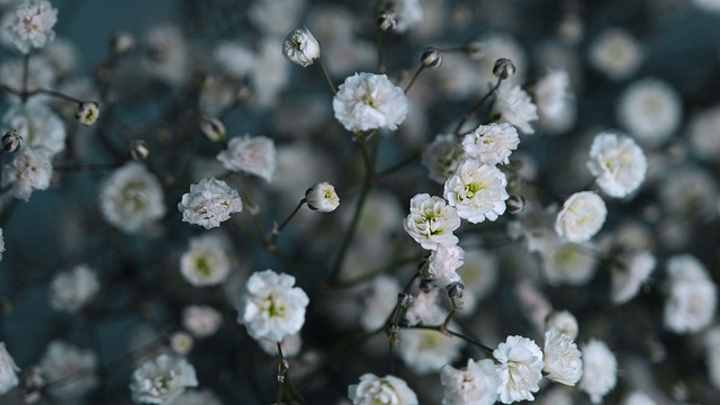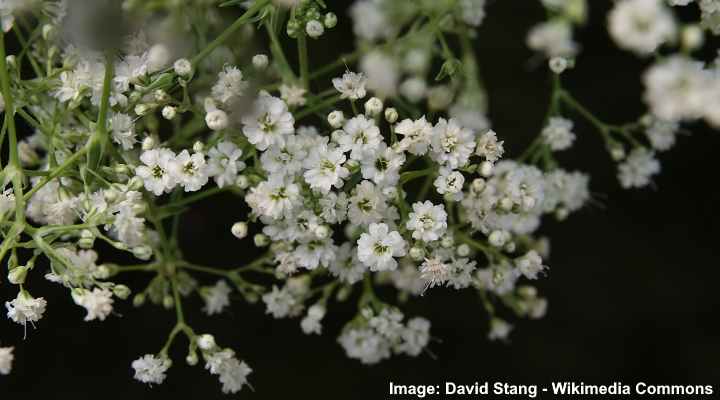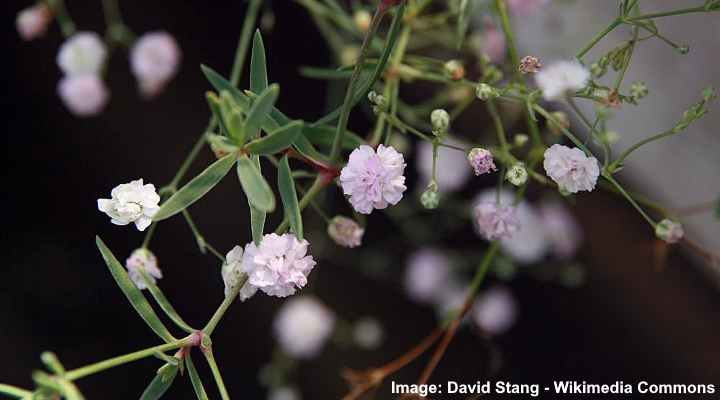Baby’s Breath Flowers (Gypsophila): Plant and Growing Guide (Pictures)

Baby’s breath flowers are small, delicate white, light pink, or yellow blooms, popular in floral arrangements and cut flowers. Flowers on baby’s breath plants grow as airy mounds of tiny blossoms that enhance aesthetics in a garden landscape. Baby’s breath plants are incredibly easy to grow and come back year after year, filling your garden with decorative clouds of cheerful flowers.
This article is a guide to planting and growing baby’s breath flowers in your garden. You’ll also find helpful tips on drying baby’s breath flowers and how to resolve various issues growing this ornamental hardy perennial.
Baby’s Breath Plant (Gypsophila)

Baby’s breath plants include many species with tiny white or pink flowers that can be single or double blooms
Baby’s breath (Gypsophila) is a fast-growing flowering plant with loose clusters of tiny flowers. There are around 150 species of plants in the genus Gypsophila that grow as annuals or hardy perennials. Baby’s breath plants are native to Europe, Asia, some parts of Africa, and Australia.
Baby’s breath plants form cloud-like mounds of light flowers that have a softening effect in gardens. Depending on the species, baby’s breath flowers grow between 6” to 8 ft. (15 cm – 2.4 m) tall and up to 4 ft. (1.2 m) wide. Some varieties of baby’s breath are creeping plants and are ideal for flowering full-sun ground cover plants.
Baby’s breath spreads by seeds and can quickly grow into a large canopy of white or pink flower clusters with slender stems.
Depending on the variety, baby’s breath can be an annual or perennial plant. Annual baby’s breath plants die off in winter. However, they tend to self-seed, and the flowers may come back the following year. Perennial baby’s breath flowers may die back to the ground in the fall, but the roots are cold-hardy to withstand frost, and they return to bloom year after year.
The botanical name of baby’s breath—Gypsophila—means “loving gypsum.” This name refers to the gypsum-rich soil that some species thrive in. It is said that the common name “baby’s breath” refers to the practice of gifting the flowers during baby showers. Other people say the name baby’s breath symbolizes the charming and innocent look of a little baby.
The most common use for baby’s breath flowers is as fillers in flower displays and arrangements. The airy clusters of tiny pink or white flowers enhance larger blooms. The delicate white flowers contrast nicely with roses, tulips, gerbera, and other colorful flowers. Baby’s breath flowers are also popular to use in bridal bouquets and floral wedding arrangements.
Baby’s Breath Flowers

Baby’s breath flowers are commonly used in flower arrangements and wedding bouquets
Flowers on baby’s breath plants are blossoms that are usually white or pink and create clouds of pretty flowers. Individual baby’s breath flowers can be five-petaled single or double and form loose clusters called panicles. Baby’s breath flower heads measure between 3” and 6” (7.5 – 15 cm) across.
Flowers on the popular annual baby’s breath (Gypsophila elegans) grow up to 2 ft. (0.6 m) tall. Common Gypsophila (Gypsophila paniculata) flowering stems grow up to 3 ft. (1 m) tall. Creeping baby’s breath flowers (Gypsophila repens) only grow 8” (20 cm) tall on this mat-forming plant.
Species of Gypsophila flower from early summer until the fall. After planting baby’s breath seeds, the plant flowers from the third year.
How to Grow Baby’s Breath Plant and Flowers
Plant baby’s breath flowers in the sunniest part of your garden. Baby’s breath plants grow best in dry, well-drained alkaline soils and are tolerant of drought. Only water baby’s breath flowers during extended drought periods. Baby’s breath is cold hardy and grows well in USDA zones 3 to 9.
How to Dry Baby’s Breath – Drying Gypsophila Flower
Baby’s breath flowers are ideal for dried flower arrangements. The flowers are long-lasting, and flowers on cut stems will last between five and 14 days. You can make baby’s breath flowers last longer by drying them indoors.
To dry baby’s breath flowers, choose stems that are between 12” and 18” (30 – 45 cm) long and have half of the buds in bloom. Tie five to seven stems together with twine and hang upside down in a warm, dark room that is well-ventilated. After five or six days, the baby’s breath flowers should be papery and dry to touch.
How to Grow Baby’s Breath in Your Garden
Baby’s breath is an ideal mounding plant for growing in front or backyards. In full sun and dry soil, the clumps of flowers grow well along borders, fill gaps, or serve as a fast-growing ground cover plant.
Let’s look in more detail at how to grow this beautiful flowering hardy perennial in your garden.
Where to Plant Baby’s Breath
Baby’s breath thrives in full sun and well-drained soil. Ensure that the soil’s pH level is between 7.0 and 7.5 for best results. Because baby’s breath is an easy-care flowering garden plant, you don’t need to do much more to keep it growing when it’s established.
The most popular use of baby’s breath in gardens is as a gap filler. The clumping, airy plant creates a loose mound of pink, rose, or white flowers. Baby’s breath flowers are suitable for growing in borders, mixed flower beds, or pots and containers. You can also create beautiful ground cover with mass plantings.
When to Plant Baby’s Breath
The best time to plant baby’s breath seeds or cuttings is in late spring, after the last frost date. Baby’s breath will grow quickly from seed in the ground without starting indoors first. However, you can also start seeds earlier indoors if you prefer and then transplant after the risk of frost has passed.
How to Grow Baby’s Breath from Cuttings
Cuttings are the easiest way to propagate new baby’s breath plants in your garden. Take cuttings of healthy stems that are at least 3” to 5” (7.5 – 12 cm) long. You will need to root them indoors before transplanting them in your garden.
To grow baby’s breath from cuttings, take your cut stems and remove all leaves from the lower third part. Place ends of the stems in small containers that contain fertile, alkaline soil. Mist the soil regularly to keep it moist but not too damp. After four weeks, transplant the rooted cuttings to your garden.
Plant the baby’s breath cuttings about 12” (30 cm) apart in the sunniest part of your garden. Water the ground to encourage plant growth. Until the new baby’s breath plants are established, you’ll need to ensure the soil is moist but never soggy.
The advantage of propagating baby’s breath from cuttings rather than seeds is that they will start to flower faster.
Growing Baby’s Breath from Seeds
It’s straightforward to grow new baby’s breath plants in your garden from seed. To grow baby’s breath plants from seed, you have two choices—sow directly in the ground after any frost risk has passed or start the seeds indoors.
To grow baby’s breath from seeds, sow them directly in the ground in a sunny spot in your garden. Sprinkle a light layer of seeds and gently cover them with soil. Lightly water the ground to keep the soil moist. When seedlings start to grow, thin them so that they are growing 12” (30 cm) apart.
To start baby’s breath from seeds indoors, sow them in a light, suitable potting mix. Cover with some seed starting formula. The best time to start is six to eight weeks before you plan to transfer the seedlings in spring. Seedlings should appear in ten to 14 days.
After baby’s breath seedlings appear, put the potting trays or pots in a sunny location. Use plant lights to ensure the plants get 16 hours of sunlight daily. When the risk of frost has passed and the seedlings have at least two pairs of leaves, they are ready to transfer to your garden.
Before planting in the ground, place the potted seedlings in a sheltered location outdoors. This process allows the plant to harden. After a week, transfer the small baby’s breath plants and grow them 12” (30 cm) apart in organically rich, alkaline soil.
Can You Divide Baby’s Breath Plants to Propagate Them?
It’s best not to divide a baby’s breath plant to grow new plants. Digging up an existing plant easily damages the roots and can kill the plant. To propagate new baby’s breath plants, use seeds or cuttings rather than root division.
As a mounding plant, baby’s breath can grow reasonably wide. In some areas, baby’s breath is considered an invasive plant. To control its growth, it’s best to cut back unwanted stems or foliage.
How to Transplant Baby’s Breath Plants
Another way to grow baby’s breath plants in your garden is to buy nursery transplants. This is an effective way if you don’t want to wait for seeds to sprout or you don’t have an existing plant to take cuttings.
Before transplanting rooted nursery baby’s breath plants, it’s vital to prepare the soil. Turn the ground between 6” and 12” (15 – 30 cm) deep and work in compost or leaf mold. Dig a small hole for each plant that has enough room for the root ball. Ensure that the soil line on the plant is level with the ground. Fill the remaining space with soil and press down firmly.
After transplanting a baby’s breath plant, water the ground thoroughly. Then add a layer of mulch about 2” (5 cm) deep. Water the newly planted baby’s breath plants when the top 1” (2.5 cm) of soil dries out. Until the plants are established, water them weekly unless there is rainfall.
Baby’s Breath Care — Light Requirements
Baby’s breath performs best in full sun when it gets at least six hours of daily sunlight. On especially hot days, some partial shade is acceptable. However, the mounding floral stems need plenty of light to grow well. Too much shade inhibits flowering and creates leggy growth.
The Best Soil for Growing Baby’s Breath
Baby’s breath grows in a wide range of soils as long as there is excellent drainage. Chalky, loamy soil is best for growing baby’s breath plants if you want full blooms of white and pink flowers. For best results, keep the soil’s pH levels between 7.0 and 7.5. You can add lime to increase the ground’s alkalinity.
The worst type of soil for perennial baby’s breath flowers is heavy clay soils. If your garden has this type of ground, consider growing baby’s breath plants in a raised flower bed. Alternatively, you can grow baby’s breath in pots or containers for your balcony, patio, or deck area.
How to Water Baby’s Breath Plants
Baby’s breath is a drought-tolerant flowering plant with minimal water needs. It thrives in dry soil and doesn’t need much care. During summer, you may have to lightly water the ground once a week or less to keep the soil moist. Overwatering baby’s breath causes the large fleshy roots to rot, eventually killing the plant.
Take care when planting young baby’s breath seedlings or cuttings. The ground should be moderately moist—especially in hot weather—until the plant establishes itself.
Temperature and Humidity Growing Baby’s Breath in Gardens
Most species of baby’s breath grow in USDA zones 3 to 9. In cold climates, the stems may die back to the ground. Before planting a baby’s breath plant in your garden, check to see if it’s an annual or perennial variety and its minimal growing zone.
Typically, baby’s breath flowers thrive in dry climates. If you live in a humid environment, it’s vital to ensure that the ground drains well. Otherwise, your mounding garden plant may show signs of fungal leaf damage.
Pruning Baby’s Breath
Baby’s breath has minimal pruning requirements. You only need to prune long, leggy stems to keep the bushy flowering mound looking its best.
To encourage blooming throughout the summer, you can deadhead the terminal flowers when they start to die. It’s best to trim back the stems to where the secondary sprays start growing. This type of pruning helps ensure that flowers last until the fall.
Once the secondary blooming has finished, you can cut back baby’s breath stems to about 1” (2.5 cm) above the ground. Cover the root base with a layer of mulch to protect roots from frost. New stems should emerge the following spring.
Is Baby’s Breath Toxic?
Baby’s breath plants contain irritants that can be mildly toxic to animals and humans. According to the University of California, Gypsophila paniculata is on the list of toxic plants that cause dermatitis, itching, and skin irritation.
When pruning a baby’s breath plant, always wear protective gloves to protect your skin from the plant’s sap.
How to Resolve Issues Growing Baby’s Breath in Your Yard
Baby’s breath is a hardy, robust plant that doesn’t easily succumb to pests or diseases. When Gypsophila species grow in dry soil and get plenty of sunshine, they rarely have growing problems. However, there are a few baby’s breath issues to be aware of.
Leafhoppers and aphids can affect baby’s breath foliage. These pesky green insects feed on plant sap, and their damage causes distorted or discolored leaves. Leafhoppers tend to affect young baby’s breath plants. So, try protecting them in spring with row covers during the first month after planting in your garden.
Excess soil moisture, dampness on leaves, and poor air circulation can cause fungal infections. If you notice dusty gray mold on foliage, try thinning the plant to increase air circulation. Also, when watering, avoid splashing water on the lower leaves.
Crown and root rot usually cause stems to turn mushy and emit a bad odor. To prevent roots from decaying, keep the soil as dry as possible, only watering it occasionally. It’s also vital to leave a 2” (5 cm) radius free from mulch around the main stems. This helps prevent moisture from killing roots.
Varieties of Baby’s Breath
Here are a few popular baby’s breath varieties:
Gypsophila elegans—An annual baby breath plant with large, open blooms featuring pretty white flowers. This baby’s breath species is typically used in bouquets and flower arrangements.

Gypsophila elegans (Baby Breath, Maiden’s Breath, Showy Baby’s Breath)
Gypsophila repens— This creeping baby’s breath plant forms a mat of foliage and flowers. It’s ideal for rock gardens or ground cover.

Gypsophila repens (Creeping Baby’s Breath)
Gypsophila paniculata—The Common Gypsophila is another popular flower for floral displays thanks to its beautiful airy panicles. This is a perennial baby’s-breath with a mass of tiny flowers.

Gypsophila paniculata (common baby’s breath)
Gypsophila paniculata ‘Bristol Fairy’—The baby’s breath plant has tiny, delicate double white flowers 0.25” (0.5 cm in diameter). Its stems grow 3 ft. (1 m) tall, and it has a mound shape.

Gypsophila paniculata ‘Bristol Fairy’
Gypsophila paniculata ‘Festival Star’—This hardy baby’s breath cultivar is suitable for growing in USDA zone 3. Its best feature is clusters of spectacular white blooms growing on 1-foot (30-cm) tall stems.

Gypsophila paniculata ‘Festival Star’
Gypsophila paniculata ‘Viette’s Dwarf’—This baby’s breath cultivar is a compact, mound-forming plant that grows 12” to 15” (30 – 38 cm) tall. Its attractive feature is double pink flowers growing in airy clusters.

Gypsophila paniculata ‘Viette’s Dwarf’
Related articles:
- Beautiful Purple Flowering Vines (With Pictures)
- The Best Ground Cover Plants With Purple Flowers
- Amazing Varieties of Daisies
